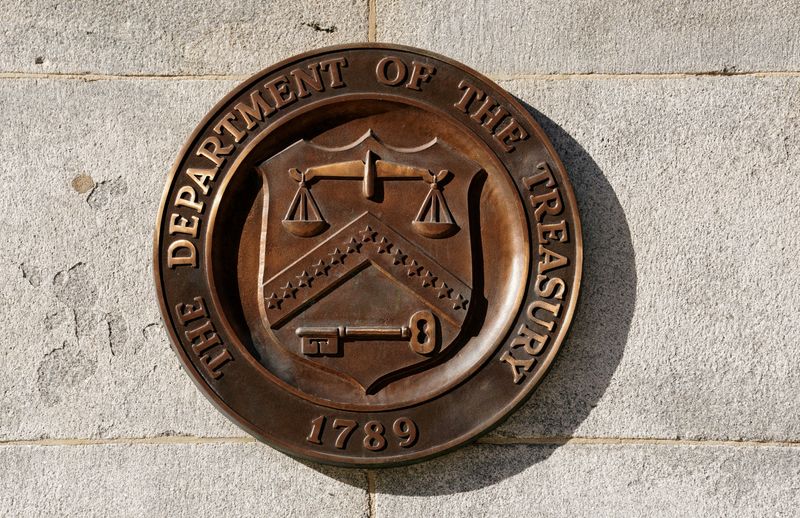By Jamie McGeever
ORLANDO, Florida (Reuters) -Stick it out, double down, or cut your losses?
This is the dilemma many fund managers are facing regarding the bond portion of their portfolio as the final quarter of a potentially historic year for U.S. Treasuries gets underway.
Treasuries are on track to record a rare hat trick and post annual losses for the third year in a row, something that has never happened in the history of the U.S. Republic, according to Bank of America, citing data going back to 1787.
Treasury bond indexes are down as much as 2.5% this year, not a huge move and most of it has come since Federal Reserve policymakers published their upwardly revised median policy projections on Sept. 20.
For an investor with a typical portfolio weighted 60% stocks and 40% bonds, these losses are more than offset by double-digit equity returns. Analysts at Truist calculate a 60/40 portfolio using the S&P 500 and Bloomberg U.S. Aggregate Bond Index is up around 7% so far this year.
But relative to expectations in January, owning bonds this year has been disastrous. Hot on the heels of the worst year ever for Treasuries in 2022 - the ICE BoFA U.S. Treasury Index plunged 13% - this was meant to be 'the year of the bond'.
It hasn't panned out that way. The two-year Treasury yield recently hit a 17-year high of 5.20% and the 10-year yield on Tuesday climbed above 4.75% for the first time since 2007 as investors adjust to the dawning reality that policy will remain restrictive until inflation is back down at the Fed's 2% target.
But the slide in bond prices has made the 'risk/reward' of holding bonds much more tempting. The equity risk premium, the compensation investors demand for holding 'riskier' stocks over 'safer' Treasuries, is by some measures the lowest in 16 years.
And the coupon on U.S. Treasuries is now juicy enough to help offset further potential price declines. A 50 basis point rise in the 10-year yield from current levels, for example, equates to around a price fall of around 4%, which is more than covered by the current yield of 4.75%.
"We would be holding onto bonds here. We would not be looking to sell at these levels," says Keith Lerner, co-chief investment officer at Truist Advisory Services. "You are getting better compensated now."
DOUBLE-DIGIT RETURNS?
Treasuries are cheap, and for good reason. The deficit is widening, debt issuance for fiscal year 2023 is approaching $2 trillion, the Fed is running down its balance sheet, and there is growing concern that demand for government paper is wilting.
But they are now cheap enough that they look attractive. And not just relative to the post-Great Financial Crisis era of zero interest rates, quantitative easing and Fed buying, but relative to the pre-2008 world too.
Analysts at UBS note that yields are well above long-term equilibrium levels, and recommend investors position for a year of double-digit returns from Treasuries ahead as growth slows and inflation continues to fall.
Their base case is for a 14% return on 10-year Treasuries, rising to 20% in the event of recession. Even in their upside scenario of a more resilient economy, 10-year Treasuries should return around 10% over the coming year, they estimate.
That might sound bullish, yet probably still not as bullish as investors were at the start of the year. A look back at how asset managers were positioned at the start of 2023 is quite an eye-opener.
Bank of America's monthly global fund manager survey last December showed that investors' positioning in equities relative to bonds was the lowest since March 2009. Investors were net overweight bonds for the first time since April 2009. And investors expected government bonds to be the best performing asset of 2023.
Commodity Futures Trading Commission data, meanwhile, showed that asset managers had built up a then record net long position in 10-year Treasuries futures of 1.26 million contracts by mid-January. That rose to 1.43 million contracts last month.
Of course, few predicted how sticky U.S. inflation would be, how aggressive the Fed would be to bring it down, and despite all that, how resilient the economy would be.
But that was then, this is now.
"We are in a position where yield levels can cushion investors and as investors consider fixed income allocations in Q4 and going into 2024, that starting point is attractive," said Jonathan Duensing, head of U.S. fixed income at Amundi US.
It is true that institutional funds with a long-term horizon are better equipped to take advantage of higher coupons than investors buying bond indices and bond funds who might find it harder to bear a few quarters of mark-to-market losses.
But the tightening and economic cycles are in their late stages, meaning bonds are probably more attractive now than they were a year ago. To investors of all stripes.
(The opinions expressed here are those of the author, a columnist for Reuters.)
(By Jamie McGeever; Editing by Andrea Ricci)
